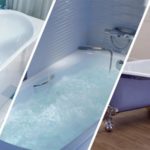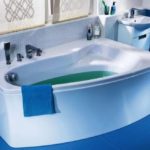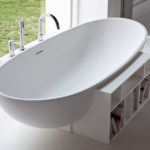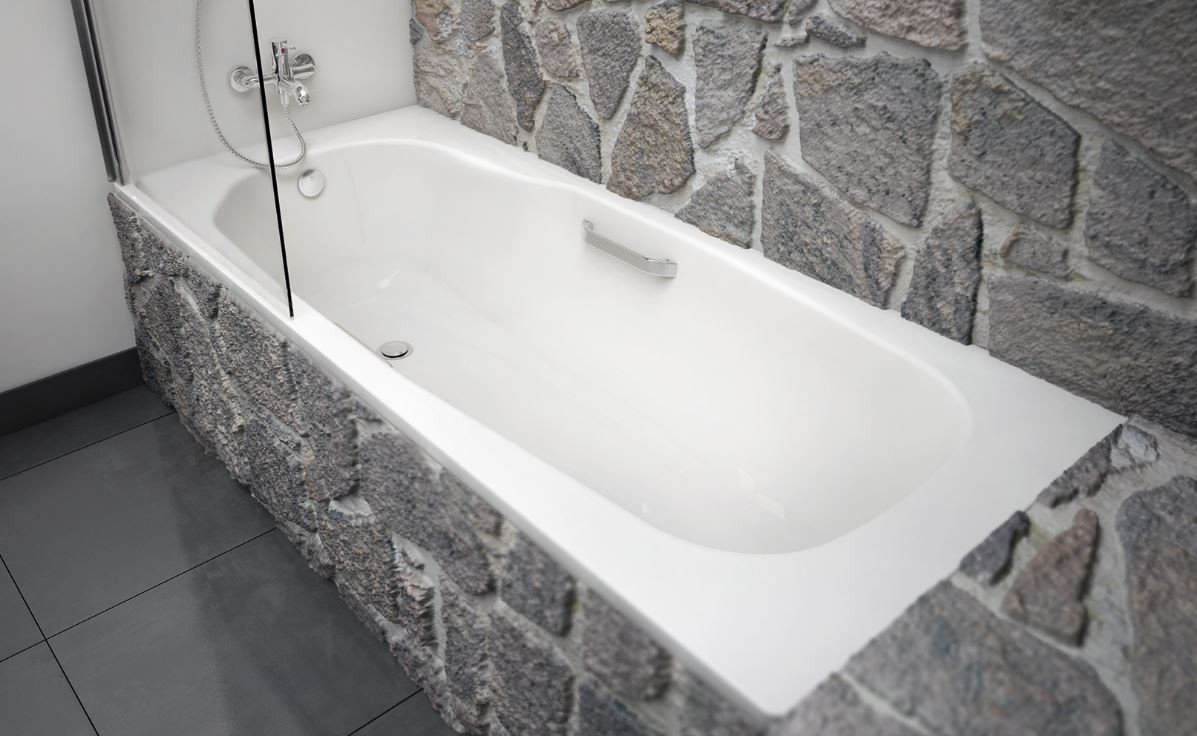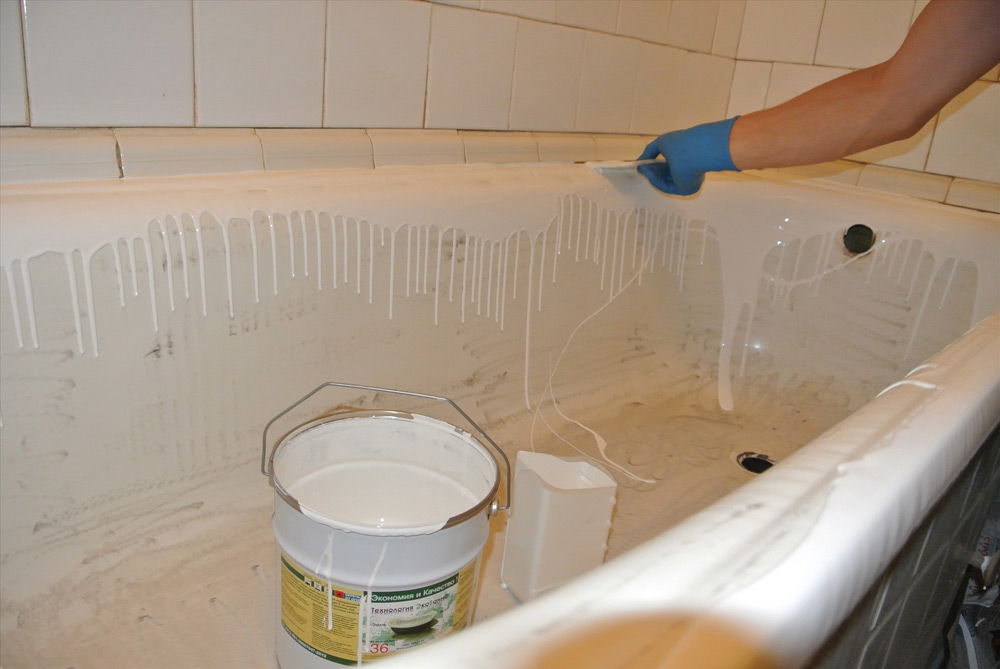Which bath is better?
Just half a century ago, our compatriots did not have to rack their brains over which bathtub to buy to replace one that had fallen into disrepair: in plumbing stores you could only see white cast iron and steel products of standard sizes. Now their choice is so large that you have to spend more than one day studying the offers of suppliers. So, let’s figure out what bathtubs manufacturers offer today and how to choose something good from all this variety.
The content of the article
Comparative characteristics of baths
Made from different raw materials, but similar in some respects, bathtubs also have individual characteristics.
Variety of forms and companies
Cast iron bathtubs are the most “conservative” - rectangular and oval. This is due to the characteristics of the metal - it strong and fragile at the same time, so giving it another shape is quite difficult. The most famous European manufacturers are Roca and Novial (Spain), Castalla (Italy), Jacob Delafon (France). In Russia, we can highlight the Novokuznetsk “Universal” and the Kirov Plant.
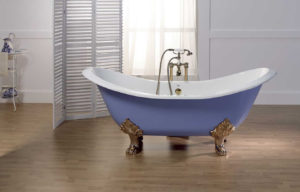 Steel and acrylic bathtubs, due to the flexibility of the material and manufacturing method, are presented in a wider range.You can find a variety of modifications - round, oval, rectangular, symmetrical and asymmetrical.
Steel and acrylic bathtubs, due to the flexibility of the material and manufacturing method, are presented in a wider range.You can find a variety of modifications - round, oval, rectangular, symmetrical and asymmetrical.
Because acrylic bathtubs are in greatest demand among consumers, there are many manufacturers on the world market that produce such products. Among the best are Vagnerplast and Ravak (Czech Republic), Riho (Holland), Cersanit (Poland), PoolSpa (Spain), 1Marka, Bas, Triton (Russia). Popular manufacturers of steel bathtubs are BLB (Portugal), Roca (Spain), Kaldewei and Bette (Germany), Verkh-Isetsky Metallurgical Plant (Russia).
The walls of glass baths most often have a rectangular shape. The production of such products is carried out by Gruppo Treesse and Regia (Italy), Knief (Germany), Doctor Jet (Russia).
Bath configuration from solid natural stone depends on the features of the equipment that “removes everything unnecessary”; from cast marble – from the form for pouring. The Russian market for products made from marble chips is dominated by domestic manufacturers Estet, Astra-Form, Esse and their European competitors Victoria+Albert (Great Britain), Jacob Delafon (France) and Riho (Holland).
Weight and dimensions
The weight of the product depends on the structure of the material, wall thickness, dimensions (length, width, height) and equipment. Approximate weight:
- cast iron bath from 80 to 150 kg;
- steel – from 25 to 55 kg;
- acrylic – from 15 to 50 kg;
- glass – from 70 kg;
- marble - from 100 kg.
Exclusive models may weigh more.
Standard bath parameters:
- length: from 120 to 180 cm;
- width: from 70 to 85 cm;
- depth: from 35 to 50 cm.
In non-standard products, dimensions are limited only by the manufacturer’s imagination.
When thinking about the size of the bathtub, you need to take into account bathroom dimensions. In typical apartments, standard bathtubs are more often installed: sit-down or full-size (150-180 cm long).
Complexity and types of installation
A variety of bathtub designs require different types of installation. Its complexity depends on many factors:
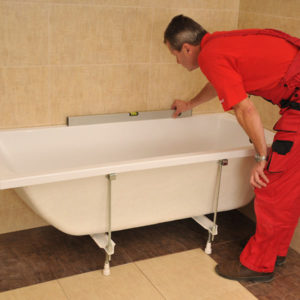 features of the floor in the bathroom (flat or not);
features of the floor in the bathroom (flat or not);- weight (the lighter the bath, the easier the installation);
- the distance from the floor to the bottom of the product and the location of the drain holes;
- the presence of “filling” in the form of hydromassage and other devices.
According to the place of attachment, the bathtub can be:
- wall;
- angular;
- free-standing.
By installation method:
- on legs;
- on a frame;
- on the floor (provided the bottom is absolutely flat);
- on the podium.
Attention! If the installation is not difficult (for example, a steel model with adjustable legs, without additional comfort elements), you can do it yourself. In other cases, it is better to entrust the work to specialists.
Surface care tips
It must be regular, then the use of aggressive agents will not be necessary, although cast iron and steel bathtubs are not particularly afraid of them. And here acrylic and marble bathtubs do not tolerate exposure to alkali, acids and abrasive particles.
Main problem with glass bathtubs - streaks on dry glass, otherwise they can be easily cleaned with a soft sponge and liquid products. To add shine, you can use a spray and a dry cloth.
Attention! For preventative purposes, it is better to gently clean any bathtub of soap residues and organic particles after each use and wipe dry. Do not use hard brushes or metal floats.
Durability of use
With proper care, the service life of acrylic bathtubs is from 10 to 15 years, steel and glass – up to 30 years (depending on the wall thickness), marble – about 40 years, cast iron – up to 50 years or more.
Comfort to use
 The most comfortable are cast iron and stone baths. They are stable, silent, and release heat slowly. Acrylic and glass are also quite convenient if they are installed evenly, preferably on a frame. Steel baths are a good option if you provide them with heat and sound insulation.
The most comfortable are cast iron and stone baths. They are stable, silent, and release heat slowly. Acrylic and glass are also quite convenient if they are installed evenly, preferably on a frame. Steel baths are a good option if you provide them with heat and sound insulation.
Cost of products
In addition to the material, the final figure is influenced by many indicators, including dimensions, equipment and design. The most “democratic” price is for steel and cast iron specimens. The most expensive are glass and marble models.
Comparison of bathtubs by material
Bathtubs made from different raw materials have their own advantages and, accordingly, disadvantages.
Cast iron
It was this material that in 1925 in Spain at the Roca brothers plant became the first for the production of bathtubs on an industrial scale. Cast iron is an alloy of iron and carbon in the form of graphite or cementite. It is poured into a mold, then the metal base is removed, cleaned mechanically, provided with holes for draining and overflowing, primed, dusted with enamel powder and fired at high temperatures (about 1000˚) until a glassy coating is obtained.
Reference! Domestic manufacturers use zirconium salts as part of the enamel coating, while Western manufacturers use titanium salts. The bond with titanium makes the surface smoother, more even and less susceptible to scratches and rust.
Advantages of cast iron baths:
- durability;
- structural stability and coating strength;
- slow heat transfer;
- sound insulation.
Flaws:
- heavy weight;
- monotony of forms.
Steel
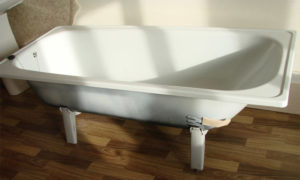 Also very popular. Steel, like cast iron, is a compound of iron and carbon, but there is much less of the latter in the alloy. It also contains other chemical elements. Steel is much more flexible than cast iron, it can easily be quenched, forged, welded and other methods of machining.
Also very popular. Steel, like cast iron, is a compound of iron and carbon, but there is much less of the latter in the alloy. It also contains other chemical elements. Steel is much more flexible than cast iron, it can easily be quenched, forged, welded and other methods of machining.
Bathtubs are made from two types of steel: stainless and structural. The thickness of the steel sheet is from 1.5 to 3.5 mm, which is significantly less than cast iron (5 mm or more).
By the way! When choosing a steel bathtub, it is better to give preference to a product with thicker walls (3-3.5 mm). It is stronger, the operating time and warranty period are longer.
Various bathtub shapes are created by stamping under a hydraulic press. Then all excess is cut off from the workpiece, holes are made and the mounting brackets are welded. In a special workshop, a primer and cover layer of enamel are applied to the bathtub, after which the product is fired at a temperature of 900˚.
Obvious advantages of the product:
- high strength;
- long service life and manufacturer’s warranty (especially if the walls are thick);
- light weight and reasonable cost.
Minuses:
- high thermal conductivity;
- presence of noise when drawing water;
- specimens with thin walls (1.8-2.3 mm) bend under the weight of large users and are deformed from impacts.
Acrylic
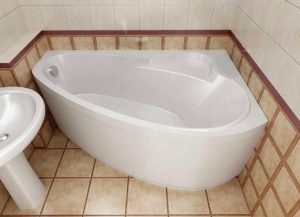 It is based on the polymer methyl acrylate, synthesized by the developers of the American company DuPont in 1952.
It is based on the polymer methyl acrylate, synthesized by the developers of the American company DuPont in 1952.
The manufacturing technology includes vacuum molding of a heated acrylic sheet inside a sealed chamber, its subsequent processing with the application of several layers of fiberglass to the surface.
Reference! The service life of the product depends on the thickness of the workpiece: up to 5 mm - 10 years, 5-6.5 mm - 12-15 years.
Advantages of acrylic products:
- light weight;
- heat preservation;
- variety of models in shape, color and size.
Flaws:
- increased susceptibility to mechanical damage, cleaning agents containing alkalis, acids and abrasive particles;
- deformation of walls due to strong heating;
- high-quality specimens are usually expensive.
Glass
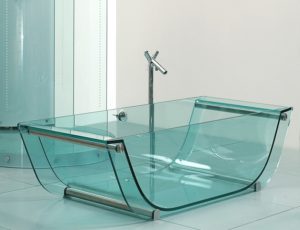 Despite the fact that glass has long been firmly established in our everyday life (windows, dishes and other objects), a bathtub made of this material is... an exclusive product that is extremely rarely found in plumbing stores. It is made of laminated tempered glass, transparent or frosted. If necessary, it can be painted in the desired color.
Despite the fact that glass has long been firmly established in our everyday life (windows, dishes and other objects), a bathtub made of this material is... an exclusive product that is extremely rarely found in plumbing stores. It is made of laminated tempered glass, transparent or frosted. If necessary, it can be painted in the desired color.
It is often installed on a frame (metal, wood) or combined with acrylic.
Main advantages:
- is not inferior in strength to metals, can withstand temperature fluctuations and the aggressive effects of chemicals;
- safety (natural material, no possibility for bacterial growth);
- the product creates the illusion of saving space and fits into any interior.
Minuses:
- difficulties during transportation and installation;
- cost from 100 thousand rubles.
Marble
Natural marble bathtubs are made from a single piece of stone. The bowl of the desired shape is cut out using special equipment, then the surface is ground and polished.
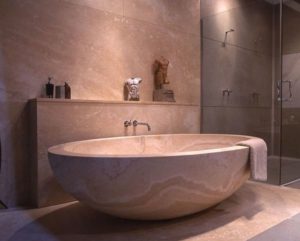 Bathtubs made of cast marble are made from a combination of natural marble chips (80%) and various resins that hold it together (20%). A marble mixture is poured into the formwork (casting mold) at a certain temperature and humidity, which dries and crystallizes. After final hardening, the formwork is removed, and the product undergoes final finishing (removal of minor defects, grinding, polishing). A special epoxy resin painted in the desired color - gelcoat - serves as a coating for the marble base, protecting it from the penetration of dirt and microbes, and increases the wear resistance of the product.
Bathtubs made of cast marble are made from a combination of natural marble chips (80%) and various resins that hold it together (20%). A marble mixture is poured into the formwork (casting mold) at a certain temperature and humidity, which dries and crystallizes. After final hardening, the formwork is removed, and the product undergoes final finishing (removal of minor defects, grinding, polishing). A special epoxy resin painted in the desired color - gelcoat - serves as a coating for the marble base, protecting it from the penetration of dirt and microbes, and increases the wear resistance of the product.
Reference! Unscrupulous manufacturers often use not crushed natural marble, but quartz sand, which has a looser structure, which ultimately affects the quality of the product.
Product advantages:
- strength and abrasion resistance;
- noiselessness;
- high thermal insulation and dielectric properties;
- Possibility of various tinting of injection molded models. Solid stone bathtubs have a unique color and pattern;
- simple repair.
Disadvantages:
- high price;
- afraid of being hit by heavy objects.
When looking for a suitable model for your home, you should not opt for the lightest or cheapest one - most likely, its manufacturer saved on something. All factors must be taken into account: product characteristics, room dimensions, user weight, care features. Only in this case will the purchase not result in disappointment, and the new bathtub will become one of the favorite places for necessary hygiene procedures and good rest.

